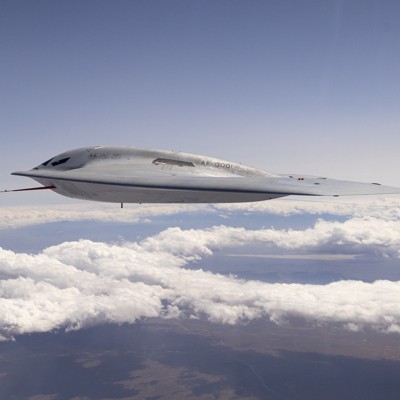A second B-21 Raider will likely fly before the end of the year, according to an Air Force official who gave a small update on the highly classified program.
“I believe it will happen before the end of the year, but we’re not going to ever give them an artificial date that they have to make if it doesn’t bring the test program along to where they need to be. We’re going to proceed as we can, efficiently, effectively, and with a sense of urgency, but we’re also going to be event-based,” said Lt. Gen. Andrew Gebara, deputy chief of staff for strategic deterrence and nuclear integration.
The stealthy B-21 first flew in November 2023, a pre-production test aircraft that has since been flying up to twice a week, builder Northrop Grumman said last year.
Northrop received the green light last year to begin B-21 production. Now the company is talking with the Air Force to speed up production after the program got an additional $4.5 billion in the reconciliation bill.
Those additional funds from Congress will go a “long way” to help the service build the bomber at scale, Gebara said today during an event hosted by the Mitchell Institute.
“We’ve done the initial R&D work, we’ve started the flight test…all these things are great indicators of success and a program that’s on time, on budget and producing, but eventually you have to get to the point where we scale this thing and so that’s very important,” he said.
The Air Force plans to buy 100 B-21s by the mid- to late 2030s, but top military officials have advocated for buying up to 145. The original program of record may be “insufficient for the future,” but Gebara said it will be a “long time” before the service comes to a conclusion on increasing the buy.
Gebara also gave an update on another nuclear modernization effort led by Northrop: the Sentinel intercontinental ballistic missile program. That program, which will replace the nation’s aging Minuteman III missiles, is being restructured after projected costs increased to $141 billion—81% above original estimates. The Air Force halted some work on Sentinel’s launch facilities after the Nunn-McCurdy breach, but has since reached an agreement with Northrop to resume work.
The service said this summer that it would have to dig hundreds of new holes for the missiles instead of reusing Minuteman silos, a major change from original plans. But Gebara said the move will save the service time and money because it can avoid the logistical and operational problems with modifying active silos.
Most of the new silos will be built on land that the U.S. already owns, but in some cases the U.S. will need to buy more land to fit the silos, Gebara said.
“I believe building all-new silos is actually not an extender of time and cost. It’s actually saving time and cost,” he said.
Nukes back in the UK?
Gebara declined to comment on recent reports that American nuclear weapons are back in the UK after almost two decades. But he did say the B61-12 nuclear gravity bomb is “fully deployed throughout the continent,” almost but not precisely echoing a statement by a senior nuclear-weapons official earlier this year.
In July, flight trackers noted that an Air Force C-17 airlifter appeared to be moving nuclear bombs to RAF Lakenheath. The F-35A is stationed at Lakenhealth and was certified to carry the B61-12 last year. Pentagon and NATO officials have a longstanding policy not to confirm the whereabouts of nuclear warheads.
“We now have F-35, 5th-gen sensor-fused aircraft, many of our allies purchasing the same aircraft, common training, common TTPs [tactics, techniques, and procedures], with our modernized B61-12 weapon that has been fully deployed throughout the continent,” Gebara said Wednesday.
That nearly echoed a January speech by Jill Hruby, who was then the administrator of the National Nuclear Safety Administration, the agency that oversees the nuclear- weapons stockpile.
“The new B61-12 gravity bombs are fully forward deployed, and we have increased NATO’s visibility to our nuclear capabilities through visits to our enterprise and other regular engagements,” she said.
Hruby stepped down as NNSA director at the beginning of the Trump administration. Brandon Williams, a former GOP congressman, was quickly named as her successor but has not been confirmed by the U.S. Senate. The NNSA website says an acting director is in place.
Read the full article here

